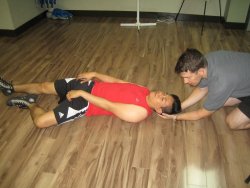Overview
Shock is something that many people are not familiar with what this really is. They often think that someone goes into shock due to being frightened or traumatized in some other way. However, medically, shock is when there is not enough blood circulating in the body. In this case, shock can become an emergency that does threaten your life. There are several causes of shock including severe burns, a spinal injury and uncontrolled bleeding. When this happen, the person is not allowing oxygen to circulate through their body, as the blood flow is impacted. If the person remains in shock for too long, they could find that damage is done to their organs and this can lead to death.
Learn More
The information posted on this page is for learning purposes only. Shock can be life threatening. Learn to manage this breathing / circulatory emergency by taking first aid training with one of our training providers. Training centers are located throughout Canada including in Vancouver, Surrey, Edmonton, Calgary, Kelowna, Winnipeg and Toronto.
The Symptoms of Shock

There are several symptoms of shock that a person needs to be aware of. These symptoms include:
- Skin is pale, cold and clammy
- Breath is shallow and rapid
- The person is having a problem breathing
- Anxiety
- Heartbeat is rapid
- The heartbeat is not regular
- The person may be thirsty or have dry mouth
- Urine is dark or low in amount
- Nausea
- Vomiting
- Dizziness
- Light headedness
- The person may be confused or disorientated
- The person may be unconscious
Shock First Aid
Shock is something that needs first aid until paramedics or other medical professionals arrive at the scene. This can be life threatening, thus these measures taken at first could save the person’s life. First aid can include:
- Loosening the clothing on the person
- If they are conscious, let them lie down and be comfortable
- Raise the legs above the torso to help increase the blood flow to the brain, lungs and heart
- If there is a spinal injury suspected, do not raise their legs as this could be doing more damage
Treating Shock
There are several treatments for shock, and which one is chosen is going to depend on what type of shock the person may be going through. The following are the types of shocks followed with the treatment of these:
- Hypovolemic Shock: The bleeding will need to be stopped and replenished with IV fluids that are put into the bloodstream. In extreme situations, a blood transfusion may be given.
- Cardiogenic Shock: With this type of shock, medications are used in order to help the heart to pump the blood better. In many cases, this type of shock may result in heart surgery.
- Neurogenic shock: This type of shock requires IV fluids, along with medications like corticosteroids.
- Septic shock: This shock is due to infection, so antibiotics may be given to help with infection. In addition, the person may need hospital care in order to help them to breathe if this becomes an issue.
- Anaphylactic shock: In these cases, the person may need antihistamines, corticosteroids or adrenaline to get back to normal.
- Obstructive shock: The obstruction will be removed, which may surgery or medication to help remove a blood clots.
- Endocrine shock: With this type of shock, a person has to have medications in order to help with hormonal imbalances.
A non-medical type of shock will basically mean talking the person back to normal. This may mean helping them deal with anxiety and stress.
Related Video On Shock
